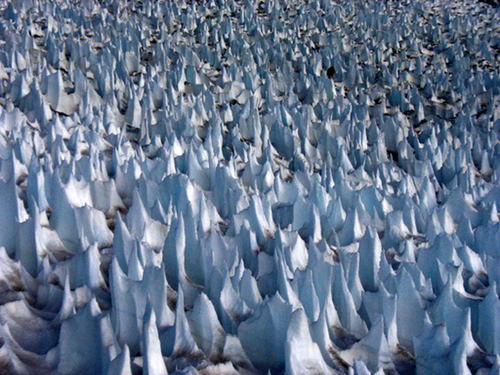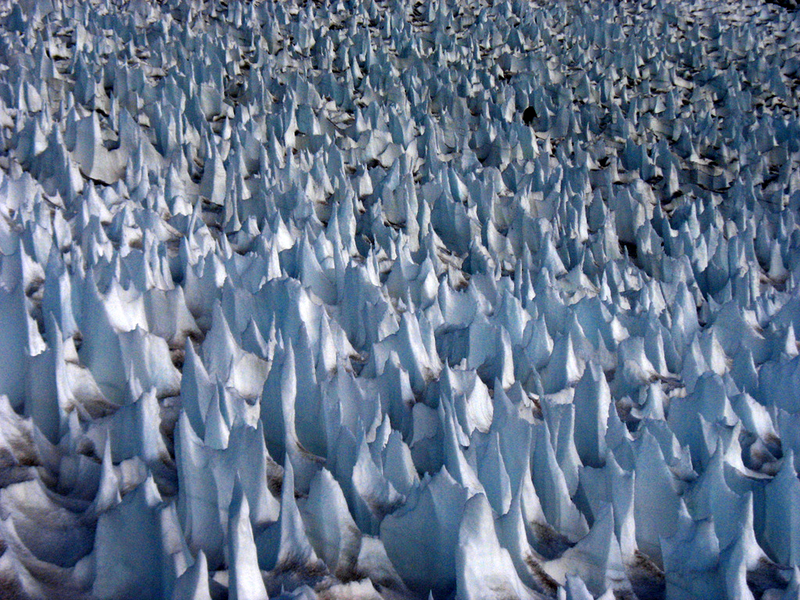Explaining the Periodicity of Snow Spikes
In the Andes, snowfields can become carved by the sun’s rays into spires of snow or ice to tall and tens of centimeters wide. A new analysis of the process through which these structures initially grow includes more physical effects than the previous theory and explains why they form with a fixed size and spacing. The analysis may also apply to ice formations on other planets.
An explanation for the formation of snow spikes called penitentes—named for their resemblance to a crowd of white-hooded monks—was developed in the early 2000s by Meredith Betterton of the University of Colorado, Boulder, and her colleagues [1, 2]. Under the sunny, high-altitude conditions in parts of the Andes, sunlight causes snow to convert (sublimate) directly into water vapor. The idea from Betterton and her colleagues was that, starting with a relatively flat snow surface with only small irregularities, light bouncing back and forth within the reflective pits and depressions increases heating there above that of the slightly higher peaks. The extra heat in these cavities causes them to be gradually excavated.
The problem, say Philippe Claudin of the Institute of Industrial Physics and Chemistry (ESPCI ParisTech) and colleagues, is that this mechanism alone shouldn’t make penitentes with a preferred size or spacing, as is observed, but should create a “scale-free” distribution, with a wide range of spacings. The model of Betterton and colleagues did select a particular spacing, but only by postulating ad hoc that there is some stabilizing process, without specifying what physical process it corresponded to. Claudin and colleagues have now shown that, by adding missing ingredients to the earlier model, they can explain why one particular spacing is chosen.
One factor added by the researchers is that the snow is only sublimated once the light is absorbed and converted to heat. This seems obvious, but it means that the interior of the snow, where light is finally absorbed, is warmer than the surface layers. So there is a temperature gradient, the thickness and steepness of which depend on how readily light can penetrate into the snow. Secondly, if the air at the surface is saturated with water vapor, no more can escape from the solid phase, so the sublimation rate depends on the speed with which water vapor diffuses away from the surface.
According to the team's model, the temperature gradient adds a further mechanism—beyond the differences in irradiation described by Betterton and colleagues—for why troughs deepen in the first place. Heat is radiated less efficiently from the troughs than from the peaks, which leads to a steeper temperature gradient in the snow within the troughs. This steeper temperature gradient turns out to produce a higher sublimation rate, so that the troughs become self-amplifying in the early stages of growth.
Regarding the characteristic spacing of these troughs, Claudin and his colleagues found that vapor diffusion at the surface is essential. It’s only when there are significant local variations in the vapor content of the air just above the surface that one part of the surface can sublimate quicker than another. But lateral diffusion suppresses such differences—so if this diffusion is fast, separate penitentes can only grow a long distance apart. In other words, the separation of the penitentes increases with the diffusion rate.
The team quantifies this diffusion rate by the distance l from the surface at which the humidity drops to the ambient atmospheric value. For penitentes a few tens of centimeters apart, as seen in natural snowfields, the analysis implies that l is about , which is what one would expect for wind-free conditions.
“It is smart to add such complex effects into the analysis,” says Hans Herrmann of the Swiss Federal Institute of Technology (ETH) in Zurich. These effects, he says, enable the model to pick out a characteristic spacing.
Penitentes may be a unique situation in which solar radiation has such a strong effect on a planet's terrain, says glaciologist Doug MacAyeal of the University of Chicago. Claudin says that similar patterns could exist on other planetary bodies that include both a form of ice and exposure to intense solar radiation, such as Jupiter’s moon Europa.
This research is published in Physical Review E.
–Philip Ball
Philip Ball is a freelance science writer in London. His latest book is How Life Works (Picador, 2024).
References
- M. D. Betterton, “Theory of Structure Formation in Snowfields Motivated by Penitentes, Suncups, and Dirt Cones,” Phys. Rev. E 63, 056129 (2001).
- V. Bergeron, C. Berger, and M. D. Betterton, “Controlled Irradiative Formation of Penitentes,” Phys. Rev. Lett. 96, 098502 (2006).





